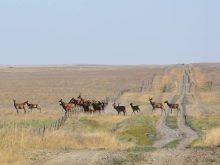A consumer battle is heating up across rural Manitoba as natural gas co-operatives provide a workable alternative to the province’s sole distributor Centra Gas, says one consultant.
“Natural gas is almost half the price of electricity so when you’re heating a house, shop and maybe a hog barn, it adds up,” said Keith Arthur, of K.G. Consulting, in Gladstone, Man.
As a farmer in the area for 20 years, Arthur said producers got tired of lobbying Centra Gas to provide local service.
“It just went on for years and years,” he said.
Read Also

Crop quality looks good this year across Prairies
Crop quality looks real good this year, with the exception of durum.
That’s when Arthur decided to take a trip to Alberta, where over 70 gas co-ops service 80 percent of rural areas in the province.
“What we wanted to do here was what they’ve been doing there for 20 years.”
The Gladstone/Austin Natural Gas Co-op, formed in 1995 as the province’s first natural gas co-op, includes among its 400 members three small towns and several farms.
Farmers pay about $2,500 to hook up. Town residents pay $750. About 20 percent of the gas bill goes toward monthly debt payments on the $3 million project.
Arthur quit farming and was hired as project director for the co-op. Now he’s using that experience to help six other Manitoba municipalities tap into the secret of natural gas co-operatives.
The real pay-off in setting up a co-op comes a long way down the line, but it should be worth the wait, Arthur said.
The Alberta model shows that after about 20 years of financing the capital costs, most of the debt is paid down and members can start enjoying lower rates.
“In 50 percent of the cases, gas to farms will be cheaper than gas in town,” Arthur said, adding the Alberta model shows a 25 percent decrease in natural gas rates 20 years after start-up.
And that’s making Centra Gas nervous, Arthur said.
“People in towns are going to throw a fit. I think what they’re really worried about is 20 years down the road these natural gas co-ops will be getting their bills paid and selling gas cheaper than what (Centra Gas) would like to.”
An official with the company said it is ready to compete with co-operatives, and is quick to caution municipalities not to be swayed by promises of future performance.
“They may have to pay more on the expectation that there would be some dividends coming back to the municipality in the future,” said Ian Anderson, vice-president of marketing and business development for Centra Gas.
“That’s an expectation, I don’t know that it is forever a certainty.”
Anderson said the company is talking to the same municipalities about the Centra Gas option to their natural gas needs. He said the company can save rural areas the headache of setting up a system on their own.
“I want the co-ops to be viewed on the same level as our proposals and municipalities will have to make a decision.”
Arthur said farmers around Carberry, a town east of Brandon, will likely form the province’s second natural gas co-op.
People who live in Carberry get natural gas through a connection to the Trans Canada Pipe-line just north of the town, “but no farmers are hooked up and these people are fed up with it. They’ve said ‘enough is enough, we’ll do it ourselves’.”
Once a municipality decides to look into forming a co-op, Arthur said the first step is to conduct a feasibility study into the cost of setting up a distribution system.
















